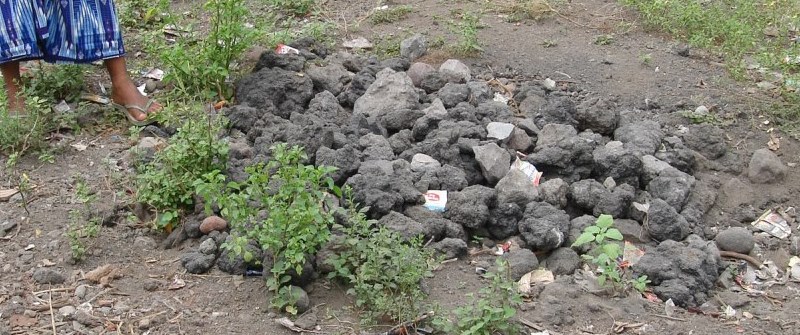
29 May Homemade monuments (blog by Gerry van Klinken)
You can’t miss the official monuments in Indonesia. They are are everywhere. Statues of Diponegoro or General Sudirman gaze out over busy traffic, which takes little notice of them. The story of national unity and military heroism that these monuments tell is familiar to everyone from their school lessons.
But how many people notice the homemade monuments? They also tell a story about the nation, perhaps a different one. There are many of them all over the country. This one stands in a small fishing village in Flores. The man next to it is the neighbourhood secretary, Pak RT. He had been sitting shirtless in the shade of his house next to it, gossiping with friends. When I arrived one afternoon in 2009, he insisted on a photo in his best shirt. He told me the monument commemmorates a remarkable event that had occurred there. He was not sure of the precise date –late 1965 or early 1966. Soon after it had happened, people planted a nanga tree on the spot. When it expired, they replaced it with the present pile of stones, so people would not forget. There is no sign; this is an oral culture.
Ende is one of the most beautiful towns in Indonesia. Its airport juts out into a bay and points towards a high rocky headland. My small plane dipped right past the rocks and took a sharp turn just before touching down.
One story I wanted to check in Ende was that of John Timu. In 1965 he had been the town’s communist party chairperson. He was loud and militant. When the military launched its crackdown on the communists in October 1965, Timu escaped to the comparative anonimity of Surabaya, in Java. A military officer who knew him lured him back with a promise of safe passage. But he was arrested anyway. One morning the local commander had a poster put up at the Pancasila monument, on the crossing down by the harbour. ‘Today at 3pm Mister Timu will be burned to death. All are invited to watch.’ The military entrusted the execution to members of the Islamic youth organization Ansor. Unspeakable atrocities were committed in those days. Slashing slogans into skin with razorblades, dragging people behind cars. A crowd was waiting for him at the designated spot, a deserted coconut grove a few kilometres east of Ende along the coastal road. They stood him up in a pile of old tires, added petrol and a match. He made no sound when he died. ‘Extremely sadistic,’ is how one man recalled it to me, a schoolboy at the time, who had been forbidden by his school teacher from attending, but who heard the story afterwards.
Half a century later, I expected this horrible incident to have been all but forgotten. Arriving on foot at Ende’s busy and smelly fishers harbour, I looked for somebody old and relaxed enough to possibly tell me about it. No sooner had a conversation started when a young man cut in: ‘The John Timu burning! You want to see the place? I’ll take you there.’ It had become a local legend. I hopped on the back of his motorcycle. Fishing settlements had expanded along the coast since 1965. A little asking here and there brought us to the men sitting next to this pile of stones in a neighbourhood called Tanjung.
It did not become clear to me exactly why the locals took so much care to preserve it. The story itself was painful to them, because they knew the cruelty had been committed by people of their own faith. Pak RT and his neighbours at first said it had been done by lots of police. When I asked if anybody else had been watching or even taking part, they at first said ‘No.’ But then they named the Ansor group, led by a man named Ali Nawe. He acted under military orders.
Unlike the gigantic official monument to the events of 1965 at Lubang Buaya outside Jakarta, this little one outside Ende carried no ideological baggage. No one mentioned the danger of communism. I suspect the stones just marked the location of a gruesome occurrence. ‘His arms rose up in the flames, like Jesus,’ someone (a Catholic) had earlier told me. This tragic moment of inexplicable brutality had literally been burnt into the earth right here. It had to be marked, so people would not trample on it in ignorance.
On 1 and 2 October this year it will be fifty years since the start of this shocking chain of events. KITLV is co-sponsoring a conference in Amsterdam to look at competing narratives about what they still mean today. You don’t have to be an expert to come along. Put it in your diary now!
1 & 2 October: international conference ‘1965 Today: Living with the Indonesian Massacres’.




No Comments